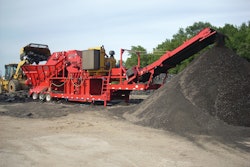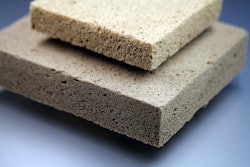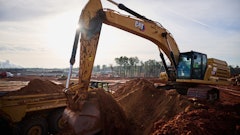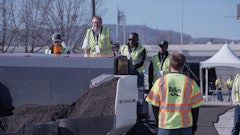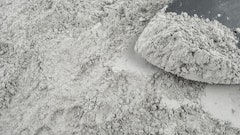
By Jon Hilkevitch
While a runway at O'Hare International Airport that opened last year is sometimes called the "cemetery airstrip'' because part of it sits on a former graveyard, the next runway set to debut in late 2015 could earn the nickname "Shingles,'' and not because Chicago officials are hoping the number of flights will go through the roof.
During the pouring of underpavement layers that began this month, O'Hare became the first U.S. airport to use recycled asphalt shingles in runway construction, according to the Federal Aviation Administration.
It's discarded material that in the past would have ended up in landfills, even though old asphalt shingles contain a valuable commodity — oil.
The two asphalt underlayers on the new O'Hare runway contain up to 3 percent oil, sand and fibers that were reclaimed from old asphalt shingles stripped off residential roofs in the Chicago area, officials said. The top layer is standard issue, a mixture called Portland cement concrete runway pavement.
In preparation for their new life, the old shingles are shredded to the consistency of coarsely ground coffee, then combined with virgin products to make a fresh asphalt mix, experts explained during a Tribune visit last week to a shingle recycling facility.
Roughly 9,500 tons of material repurposed from recycled asphalt shingles, or RAS, are going into the base of the 7,500-foot runway called 10 Right-28 Left and on nearby taxiways and service roads on O'Hare's south airfield, on land formerly in Bensenville, according to the Chicago Department of Aviation.
The city, working with consultants and researchers at the University of Illinois, began experimenting with recycled roofing shingles in 2012. Once satisfied that the resulting mixture of recycled and new products met the strength and durability standards necessary to handle aircraft operations, the city sought and received FAA approval to modify the existing runway-construction standards in late 2012, said Jonathan Leach, chief operating officer at the city Aviation Department.
"It's the right environmental thing to do,'' Leach said during an interview last week at the department's Quality Assurance and Material Testing Lab at O'Hare. He said the use of recycled shingles will be specified as a condition in all future paving contracts at O'Hare and Midway Airport.
"The hope also is that as fuel costs rise, the recycled shingles will reduce some of our construction costs,'' Leach said.
The Aviation Department estimated a cost savings of about $665,000 by using the recycled shingles for the new runway and on an adjacent taxiway project. It's a relatively small amount compared with the $82.5 million paving contract for the runway-taxiway combination or the approximately $500 million overall price tag for the entire 10 Right-28 Left project, officials acknowledged.
But the FAA approval opens the door for using recycled asphalt shingles on other runways and taxiways, on blast pads where pilots conduct jet engine run-up tests and on public access and perimeter roads, including Interstate Highway 190, which hugs O'Hare.
While O'Hare is the only U.S. airport to use recycled shingles, the concept has been a part of roadway construction for decades in other states, with the technology refined in recent years to produce a more consistent mix, according to experts.
Illinois was late to the party.
In 2010, the state joined Wisconsin, Indiana, Missouri, Iowa and many states outside the Midwest that years earlier began to allow the recycling of asphalt shingles for use in road construction projects, under federal and state Environmental Protection Agency rules.
Illinois followed up last year by banning most shingles from being dumped into landfills. The law that took effect this year forbids any landfill within 25 miles of a recycled shingle facility from accepting shingles unless they are contaminated with other materials.
The Illinois decisions spawned the creation and subsequent expansion of recycled asphalt shingle facilities, mostly in the Chicago area, including Southwind RAS LLC in northwest suburban Bartlett. The facility has taken in more than 450,000 tons of shingles since 2010, officials said.
Recycled shingles from about 130 houses and rubber from about 2,200 old tires were used in the repaving of North Michigan Avenue downtown in 2011, CDOT said. IDOT used the shingles recently on a section of I-80 in Will County, on Butterfield Road in DuPage County and on Harlem Avenue in Cook County. And the Tollway is using the sustainable resource on the Jane Addams Tollway widening and resurfacing, officials said.
In Chicago, about 90 percent of the pavement resurfacing projects conducted last year used some amount of recycled shingles, CDOT said.
The roof on a typical Chicago bungalow contains 6,000 pounds of shingles that, when recycled, help produce 400 feet of road, according to the RAS Association. The shingles from about 100 homes are equivalent to about 400 barrels of oil saved, because shingles contain 25 to 30 percent oil, the association said. The goal of the recycling process is to retain most of the oil in the finished product, which is used as a binder in roads, officials said.
Virgin liquid asphalt, depending on the grade, costs about $600 per ton, while the recycled shingle mixture sells for about $50 per ton, Lansu said.
It is estimated that $36 million to $60 million could have been saved in Illinois last year if recycled shingles were used on all road projects in the state, according to the RAS Association.
Contact Getting Around at [email protected] or c/o the Chicago Tribune, 435 N. Michigan Ave., Chicago, IL 60611; on Twitter @jhilkevitch; and at facebook.com/jhilkevitch. Read recent columns at chicagotribune.com/gettingaround.
Copyright © 2014 Chicago Tribune Company, LLC




